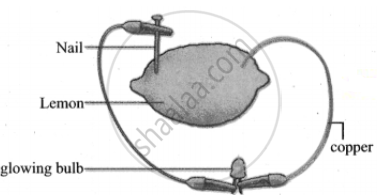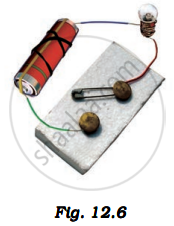Advertisements
Advertisements
Question
Rahul wants to make an electric circuit. He has a bulb, two wires, a safety pin, and a piece of copper. He does not have any electric cell or battery. Suddenly he gets some idea. He uses lemon instead of a battery and makes a circuit. Will the bulb glow?
Solution
Yes, the bulb will glow:
- Take a lemon. Squeeze it without breaking its skin. The squeezing action releases the juice inside the lemon needed as the battery works.
- Use a nail to make one hole in one end of the lemon and push a copper wire into that hole.
- Then, push the nail into the other end.
- Connect a bulb with one of the terminals with the copper wire and the other terminals with the nail, as shown in the figure.
- Now the lemon generates a small amount of electricity and the bulb glows.

APPEARS IN
RELATED QUESTIONS
Draw a schematic diagram of a circuit consisting of a battery of three cells of 2 V each, a 5 Ω resistor, an 8 Ω resistor, and a 12 Ω resistor, and a plug key, all connected in series.
Two tungsten bulbs of power 50 W and 60 W work on 220 V potential difference. If they are connected in parallel, how much current will flow in the main conductor?
The following figure shows the symbols for components used in the accompanying electrical circuit. Place them at proper places and complete the circuit.

Which law can you prove with the help of above circuit?
Tabulate the different components of an electric circuit and their respective symbols.
In which among the following circuits does the bulb glow?
Study the three electric circuits below. Each of them has a glass rod (G), a steel rod (S), and a wooden rod (W).
In which of the electric circuits would the bulb not light up.

In a circuit, if the key is in open (off) condition, then electricity will not flow.
Draw the symbols of the following circuit components.
switch in off position
Will the bulb glow in the circuit shown in Fig. 12.6? Explain.

How is Joule's law effect useful in electric circuits where fuse is used as a safety device?
